Modeling the Effects of Vegetation on Air Purification Through Computational Fluid Dynamics in Different Neighborhoods of Beijing
Abstract
1. Introduction
2. Materials and Methods
2.1. Study Area
2.2. Neighborhood Types and Data Collection
2.3. Mapping of Vegetation Greening
2.4. Simulation Preprocessing
2.5. CFD Numerical Simulation
2.6. Validation of CFD Results
2.7. Vegetation Absorption Coefficient
3. Results
3.1. Vegetation Greening Distribution
3.2. Pollutant Concentration Difference in Neighborhoods
3.3. Vegetation Greening Absorption
4. Discussion
4.1. Greening Purification Effects in Neighborhoods
4.2. Comparison and Verification of the Vegetation Absorption Coefficient
4.3. Research Limitations and Future Directions
5. Conclusions
- (1)
- Increasing the green coverage rate can be conducive to the purification of PM2.5 and CO when the rate is below 50%. According to this study’s results, a neighborhood green coverage of nearly 50% can effectively reduce ambient pollutant concentrations by 8% to 10%.
- (2)
- The size of green patches directly influences their purification effect on PM2.5 particles. In neighborhoods with severe PM2.5 pollution, more thought should be given to arranging fewer, clustered green patches rather than fragmented ones, which can more effectively remove PM2.5 and other particulates from the environment.
- (3)
- Large-scale greening has little effect on air purification in areas with dense high-rise buildings. In community design, greening should be arranged more in open spaces with less height variation between buildings. For high-rise structures, vertical greening might be a viable option.
- (4)
- Future neighborhood planning and design should prioritize vegetation in areas aligned with prevailing wind patterns, which can significantly reduce PM2.5 and CO pollutant influx.
Supplementary Materials
Author Contributions
Funding
Data Availability Statement
Conflicts of Interest
References
- Nielsen, A.B.; van den Bosch, M.; Maruthaveeran, S.; van den Bosch, C.K. Species richness in urban parks and its drivers: A review of empirical evidence. Urban Ecosyst. 2014, 17, 305–327. [Google Scholar] [CrossRef]
- Janhäll, S. Review on urban vegetation and particle air pollution—Deposition and dispersion. Atmos. Environ. 2015, 105, 130–137. [Google Scholar]
- Matos, P.; Vieira, J.; Rocha, B.; Branquinho, C.; Pinho, P. Modeling the provision of air-quality regulation ecosystem service provided by urban green spaces using lichens as ecological indicators. Sci. Total Environ. 2019, 665, 521–530. [Google Scholar] [CrossRef] [PubMed]
- Liu, W.; Zhao, H.; Sun, S.; Xu, X.; Huang, T.; Zhu, J. Green space cooling effect and contribution to mitigate heat island effect of surrounding communities in Beijing metropolitan area. Front. Public Health 2022, 10, 870403. [Google Scholar]
- Wang, Y.; Yang, S. Identification of surface thermal environment differentiation and driving factors in urban functional zones based on multisource data: A case study of Lanzhou, China. Front. Environ. Sci. 2024, 12, 1466542. [Google Scholar]
- Guyot, M.; Araldi, A.; Fusco, G.; Thomas, I. The urban form of Brussels from the street perspective: The role of vegetation in the definition of the urban fabric. Landsc. Urban Plan. 2021, 205, 103947. [Google Scholar]
- Buccolieri, R.; Jeanjean, A.P.; Gatto, E.; Leigh, R.J. The impact of trees on street ventilation, NOx and PM2.5 concentrations across heights in Marylebone Rd street canyon, central London. Sustain. Cities Soc. 2018, 41, 227–241. [Google Scholar]
- Borna, M.; Turci, G.; Marchetti, M.; Schiano-Phan, R. Evaluating the influence of urban blocks on air pollution concentration levels: The case study of Golden Lane Estate in London. Sustainability 2024, 16, 696. [Google Scholar] [CrossRef]
- Zhang, Z.; Li, Y.; Li, M.; Meng, H.; Zhang, T.; Peng, Z.; Zhang, W. Improving atmospheric particulate matter removal of residential green space based on landscape patterns and plant functional types. Air Qual. Atmos. Health 2023, 16, 401–413. [Google Scholar]
- Xu, J.; Liu, M.; Chen, H.; Luo, M. Spatially heterogeneous influence of street greenery on street-level PM2.5 pollution using mobile monitoring from a three-dimensional perspective. Urban Clim. 2023, 48, 101414. [Google Scholar]
- Bahr, S. The relationship between urban greenery, mixed land use and life satisfaction: An examination using remote sensing data and deep learning. Landsc. Urban Plan. 2024, 251, 105174. [Google Scholar] [CrossRef]
- Bachir, N.; Bounoua, L.; Aiche, M.; Maliki, M.; Nigro, J.; El Ghazouani, L. The simulation of the impact of the spatial distribution of vegetation on the urban microclimate: A case study in Mostaganem. Urban Clim. 2021, 39, 100976. [Google Scholar]
- Mohammadi, M.; Tien, P.W.; Calautit, J.K.S. Influence of wind buffers on the aero-thermal performance of skygardens. Fluids 2020, 5, 160. [Google Scholar] [CrossRef]
- Karttunen, S.; Kurppa, M.; Auvinen, M.; Hellsten, A.; Järvi, L. Large-eddy simulation of the optimal street-tree layout for pedestrian-level aerosol particle concentrations—A case study from a city-boulevard. Atmos. Environ. X 2020, 6, 100073. [Google Scholar]
- Komalasari, D.; Shi, Z.; Harrison, R.M. Optimisation of a numerical model to simulate the dispersion and chemical transformations within the oxides of nitrogen/ozone system as traffic pollution enters an urban greenspace. Earth Syst. Environ. 2021, 5, 927–937. [Google Scholar]
- Tiwari, A.; Kumar, P. Integrated dispersion-deposition modelling for air pollutant reduction via green infrastructure at an urban scale. Sci. Total Environ. 2020, 723, 138078. [Google Scholar] [PubMed]
- Lin, C.; Ooka, R.; Kikumoto, H.; Sato, T.; Arai, M. CFD simulations on high-buoyancy gas dispersion in the wake of an isolated cubic building using steady RANS model and LES. Build. Environ. 2021, 188, 107478. [Google Scholar] [CrossRef]
- Lin, X.; Fu, Y.; Peng, D.Z.; Liu, C.-H.; Chu, M.; Chen, Z.; Yang, F.; Tse, T.K.T.; Li, C.Y.; Feng, X. CFD- and BPNN-based investigation and prediction of airpollutant dispersion in urban environment. Sustain. Cities Soc. 2024, 100, 105029. [Google Scholar]
- Aly, S.H.; Zakaria, R.; Kondorura, C.F. The capability of green open space in absorbing carbon monoxide and carbon dioxide emissions in Balai Kota Makassar. IOP Conf. Ser. Earth Environ. Sci. 2020, 419, 012169. [Google Scholar]
- Leonard, R.J.; McArthur, C.; Hochuli, D.F. Particulate matter deposition on roadside plants and the importance of leaf trait combinations. Urban For. Urban Green. 2016, 20, 249–253. [Google Scholar]
- Liu, J.; Zheng, B. A simulation study on the influence of street tree configuration on fine particulate matter (PM2.5) concentration in street canyons. Forests 2023, 14, 1550. [Google Scholar] [CrossRef]
- Fellini, S.; Marro, M.; Del Ponte, A.V.; Barulli, M.; Soulhac, L.; Ridolfi, L.; Salizzoni, P. High resolution wind-tunnel investigation about the effect of street trees on pollutant concentration and street canyon ventilation. Build. Environ. 2022, 226, 109763. [Google Scholar] [CrossRef]
- Carlo, O.S.; Fellini, S.; Palusci, O.; Marro, M.; Salizzoni, P.; Buccolieri, R. Influence of obstacles on urban canyon ventilation and air pollutant concentration: An experimental assessment. Build. Environ. 2024, 250, 111143. [Google Scholar] [CrossRef]
- Wang, Y.; Flageul, C.; Maison, A.; Carissimo, B.; Sartelet, K. Impact of trees on gas concentrations and condensables in a 2-D street canyon using CFD coupled to chemistry modeling. Environ. Pollut. 2023, 323, 121210. [Google Scholar] [CrossRef] [PubMed]
- Ysebaert, T.; Koch, K.; Samson, R.; Denys, S. Green walls for mitigating urban particulate matter pollution—A review. Urban For. Urban Green. 2021, 59, 127014. [Google Scholar] [CrossRef]
- Qian, Y.; Zhou, W.; Li, W.; Han, L. Understanding the dynamic of greenspace in the urbanized area of Beijing based on high resolution satellite images. Urban For. Urban Green. 2015, 14, 39–47. [Google Scholar] [CrossRef]
- Guo, J.; Liu, Z.; Zhu, X. Assessing the macro-scale patterns of urban tree canopy cover in Brazil using high-resolution remote sensing images. Sustain. Cities Soc. 2024, 100, 105003. [Google Scholar] [CrossRef]
- Ludwig, C.; Hecht, R.; Lautenbach, S.; Schorcht, M.; Zipf, A. Mapping public urban green spaces based on OpenStreetMap and Sentinel-2 imagery using belief functions. ISPRS Int. J. Geo-Inf. 2021, 10, 251. [Google Scholar] [CrossRef]
- Yan, L.; Jia, W.; Zhao, S. The cooling effect of urban green spaces in metacities: A case study of Beijing, China’s capital. Remote Sens. 2021, 13, 4601. [Google Scholar] [CrossRef]
- BMBS (Beijing Municipal Bureau of Statistics). Beijing Statistical Yearbook 2022; China Statistics Press: Beijing, China, 2022. [Google Scholar]
- GB 50137-2011; Code for Classification of Urban Land Use and Planning Standards of Development Land. MHUDPRC (Ministry of Housing and Urban-Rural Development of the People’s Republic of China): Beijing, China; China Architecture & Building Press: Beijing, China, 2011.
- CJJ/T 85-2017; Standard for Classification of Urban Green Space. MHUDPRC (Ministry of Housing and Urban-Rural Development of the People’s Republic of China): Beijing, China; China Architecture & Building Press: Beijing, China, 2017.
- Zanaga, D.; Van De Kerchove, R.; Daems, D.; De Keersmaecker, W.; Brockmann, C.; Kirches, G.; Wevers, J.; Cartus, O.; Santoro, M.; Fritz, S. ESA WorldCover 10 m 2021 v200. Zenodo 2022. [Google Scholar] [CrossRef]
- Li, Z.; Zhang, H.; Lu, F.; Xue, R.; Yang, G.; Zhang, L. Breaking the resolution barrier: A low-to-high network for large-scale high-resolution land-cover mapping using low-resolution labels. ISPRS. J. Photogramm. 2022, 192, 244–267. [Google Scholar]
- BMCHUD (Beijing Municipal Commission of Housing and Urban-Rural Development). Beijing Construction Yearbook 2021; Beijing University of Technology Press: Beijing, China, 2021. [Google Scholar]
- ECBUTY (Editorial Committee of Beijing University of Technology Yearbook). Beijing University of Technology Yearbook 2021; Beijing University of Technology Press: Beijing, China, 2021. [Google Scholar]
- ANSYS Inc. FLUENT Training Material—ANSYS 2020 Version R1, Lecture Transient Flow Modeling, Introduction to ANSYS Fluent; ANSYS Inc.: Canonsburg, PA, USA, 2020. [Google Scholar]
- Franke, J.; Hellsten, A.; Schlunzen, K.H.; Carissimo, B. The COST 732 best practice guideline for CFD simulation of flows in the urban environment: A summary. Int. J. Environ. Pollut. 2011, 44, 419–427. [Google Scholar] [CrossRef]
- Goddard, K.A.; Craig, K.J.; Schoombie, J.; le Roux, P.C. Investigation of ecologically relevant wind patterns on Marion Island using computational fluid dynamics and measured data. Ecol. Model. 2022, 464, 109827. [Google Scholar] [CrossRef]
- Antoniou, N.; Montazeri, H.; Wigo, H.; Neophytou, M.K.A.; Blocken, B.; Sandberg, M. CFD and wind-tunnel analysis of outdoor ventilation in a real compact heterogeneous urban area: Evaluation using “air delay”. Build. Environ. 2017, 126, 355–372. [Google Scholar] [CrossRef]
- Issakhov, A.; Omarova, P. Numerical simulation of pollutant dispersion in the residential areas with continuous grass barriers. Int. J. Environ. Sci. Technol. 2020, 17, 525–540. [Google Scholar] [CrossRef]
- Franke, J.; Sturm, M.; Kalmbach, C. Validation of OpenFOAM 1.6.x with the German VDI guideline for obstacle resolving micro-scale models. J. Wind. Eng. Ind. Aerodyn. 2012, 104, 350–359. [Google Scholar]
- Zhang, P.; Cheng, H.; Jiang, Z.; Xiang, F. How sensitive morphological parameters influence on the PM2.5 diffusion: An empirical study of two neighborhoods in central Beijing. Atmosphere 2022, 13, 921. [Google Scholar] [CrossRef]
- HJ 664-2013; Technical Regulation for Selection of Ambient Air Quality Monitoring Stations. MEEPRC (Ministry of Ecology and Environment of the People’s Republic of China): Beijing, China; China Environmental Science Press: Beijing, China, 2013.
- Zheng, L.; Lu, W.; Wu, L.; Zhou, Q. A review of integration between BIM and CFD for building outdoor environment simulation. Build. Environ. 2023, 228, 109862. [Google Scholar]
- Xu, X.; Gao, Z.; Zhang, M. A review of simplified numerical approaches for fast urban airflow simulation. Build. Environ. 2023, 234, 110200. [Google Scholar]
- Jin, E.J.; Yoon, J.H.; Bae, E.J.; Jeong, B.R.; Yong, S.H.; Choi, M.S. Particulate matter removal ability of ten evergreen trees planted in Korea urban greening. Forests 2021, 12, 438. [Google Scholar] [CrossRef]
- Chen, B.; Lu, S.W.; Zhao, Y.G.; Li, S.N.; Yang, X.B.; Wang, B.; Zhang, H.J. Pollution remediation by urban forests: PM2.5 reduction in Beijing, China. Pol. J. Environ. Stud. 2016, 25, 1873–1881. [Google Scholar]
- Yan, K.; Wang, J.; Weiss, M.; Myneni, R.B. A High-Quality Reprocessed MODIS Leaf Area Index Dataset (HiQ-LAI; v1). Zenodo 2023. [Google Scholar] [CrossRef]
- Buccolieri, R.; Santiago, J.-L.; Rivas, E.; Sanchez, B. Review on urban tree modelling in CFD simulations: Aerodynamic, deposition and thermal effects. Urban For. Urban Green. 2018, 31, 212–220. [Google Scholar]
- Selmi, W.; Weber, C.; Rivière, E.; Blond, N.; Mehdi, L.; Nowak, D. Air pollution removal by trees in public green spaces in Strasbourg city, France. Urban For. Urban Green. 2016, 17, 192–201. [Google Scholar]
- Pallozzi, E.; Guidolotti, G.; Mattioni, M.; Calfapietra, C. Particulate matter concentrations and fluxes within an urban park in Naples. Environ. Pollut. 2020, 266, 115134. [Google Scholar]
- Yin, Z.; Zhang, Y.; Zhang, R.; Chen, G.; Cong, Y.; Ma, K. Structure of an urban green space indirectly affects the distribution of airborne particulate matter: A study based on structural equation modelling. Urban For. Urban Green. 2022, 72, 127581. [Google Scholar]
- Chen, X.; Wu, J.; Yang, W.; Wang, Z.; Chen, S.; Hu, X.; Lu, K.; Fan, Z.; Lin, M.; Chen, P. Measuring and modeling the effects of green barriers on the spatial distribution of fine particulate matter at roadside. Urban Clim. 2023, 52, 101727. [Google Scholar]
- Wu, J.; Long, J.; Liu, H.; Sun, G.; Li, J.; Xu, L.; Xu, C. Biogenic volatile organic compounds from 14 landscape woody species: Tree species selection in the construction of urban greenspace with forest healthcare effects. J. Environ. Manag. 2021, 300, 113761. [Google Scholar] [CrossRef]
- Duan, X.; Gu, H.; Lam, S.S.; Sonne, C.; Lu, W.; Li, H.; Chen, X.; Peng, W. Recent progress on phytoremediation of urban air pollution. Chemosphere 2024, 349, 140821. [Google Scholar] [CrossRef]
- Li, H.; Zhu, X.; Kong, W.; Zheng, M.; Guo, X.; Wang, T. Physiological response of urban greening shrubs to atmospheric particulate matter pollution: An integral view of ecosystem service and plant function. Environ. Exp. Bot. 2023, 213, 105439. [Google Scholar]
- Kuo, C.; Wang, R.; Lin, Y.; Lai, C. Urban design with the wind: Pedestrian-level wind field in the street canyons downstream of parallel high-rise buildings. Energies 2020, 13, 2827. [Google Scholar] [CrossRef]
- Wen, Y.; Huang, Z.; Tang, Y.; Li, D.; Zhang, Y.; Zhao, F. Air exchange rate and pollutant dispersion inside compact urban street canyons with combined wind and thermal driven natural ventilations: Effects of non-uniform building heights and unstable thermal stratifications. Sci. Total Environ. 2022, 851, 158053. [Google Scholar] [PubMed]
- Lind’en, J.; Gustafsson, M.; Uddling, J.; Watne, A.; Pleijel, H. Air pollution removal through deposition on urban vegetation: The importance of vegetation characteristics. Urban For. Urban Green. 2023, 81, 127843. [Google Scholar] [CrossRef]
- Jeanjean, A.P.R.; Buccolieri, R.; Eddy, J.; Monks, P.S.; Leigh, R.J. Air quality affected by trees in real street canyons: The case of Marylebone neighbourhood in central London. Urban For. Urban Green. 2017, 22, 41–53. [Google Scholar]
- Hsu, K.-W.; Chao, J.-C. Economic valuation of green infrastructure investments in urban renewal: The case of the station district in Taichung, Taiwan. Environments 2020, 7, 56. [Google Scholar] [CrossRef]
- Adler, A.W.; Bennett, D.H.; Modera, M.P. Reducing inter-unit pollutant transfer through multifamily unit compartmentalization. Indoor Environ. 2024, 1, 100014. [Google Scholar]
- Jiang, Z.; Cheng, H.; Zhang, P.; Kang, T. Influence of urban morphological parameters on the distribution and diffusion of air pollutants: A case study in China. J. Environ. Sci. 2021, 105, 163–172. [Google Scholar]
- Kong, F.; Sun, C.; Liu, F.; Yin, H.; Jiang, F.; Pu, Y.; Cavan, G.; Skelhorn, C.; Middel, A.; Dronova, I. Energy saving potential of fragmented green spaces due to their temperature regulating ecosystem services in the summer. Appl. Energy 2016, 183, 1428–1440. [Google Scholar]
- Lin, M.; Hang, J.; Li, Y.; Luo, Z.; Sandberg, M. Quantitative ventilation assessments of idealized urban canopy layers with various urban layouts and the same building packing density. Build. Environ. 2014, 79, 152–167. [Google Scholar]
- Moradpour, M.; Afshin, H.; Farhanieh, B. A numerical investigation of reactive air pollutant dispersion in urban street canyon with tree planting. Atmos. Pollut. Res. 2017, 8, 253–266. [Google Scholar]
- Santiago, J.L.; Borge, R.; Martin, F.; de la Paz, D.; Martilli, A.; Lumbreras, J.; Sanchez, B. Evaluation of a CFD-based approach to estimate pollutant distribution within a real urban canopy by means of passive samplers. Sci. Total Environ. 2017, 576, 46–58. [Google Scholar] [PubMed]
- Amorim, J.H.; Rodrigues, V.; Tavares, R.; Valente, J.; Borrego, C. CFD modelling of the aerodynamic effect of trees on urban air pollution dispersion. Sci. Total Environ. 2013, 461, 541–551. [Google Scholar] [PubMed]
- Hong, B.; Qin, H.; Lin, B. Prediction of wind environment and indoor/outdoor relationships for PM2.5 in different building-tree grouping patterns. Atmosphere 2018, 9, 39. [Google Scholar] [CrossRef]
- Salim, M.H.; Schlünzen, K.H.; Grawe, D. Including trees in the numerical simulations of the wind flow in urban areas: Should we care? J. Wind Eng. Ind. Aerodyn. 2015, 144, 84–95. [Google Scholar]
- Song, Y. Dust retention and influencing factors of nine common greening tree species in Beijing. S-Cent Agric. Sci. Technol. 2022, 43, 100–104. [Google Scholar]
- Li, S.; Liu, B.; Lu, X.; Lu, S.; Chen, J.; Li, H. Relationship between leaf surface morphology and PM2.5 adsorption capacity of common greening tree species in Beijing. Environ. Sci. Technol. 2016, 39, 62–68. [Google Scholar]
- Luo, J.; Niu, Y.; Zhang, Y.; Zhang, M.; Tian, Y.; Zhou, X. Dynamic analysis of retention PM2.5 by plant leaves in rainfall weather conditions of six tree species. Energy Sources Part A Recovery Util. Environ. Eff. 2020, 42, 1014–1025. [Google Scholar]
- Zhang, W.; Wang, B.; Niu, X. Relationship between leaf surface characteristics and particle capturing capacities of different tree species in Beijing. Forests 2017, 8, 92. [Google Scholar] [CrossRef]
- Zhao, X.; Yan, H.; Liu, M.; Kang, L.; Yu, J.; Yang, R. Relationship between PM2.5 adsorption and leaf surface morphology in ten urban tree species in Shenyang, China. Energy Sources Part A Recovery Util. Environ. Eff. 2019, 41, 1029–1039. [Google Scholar] [CrossRef]
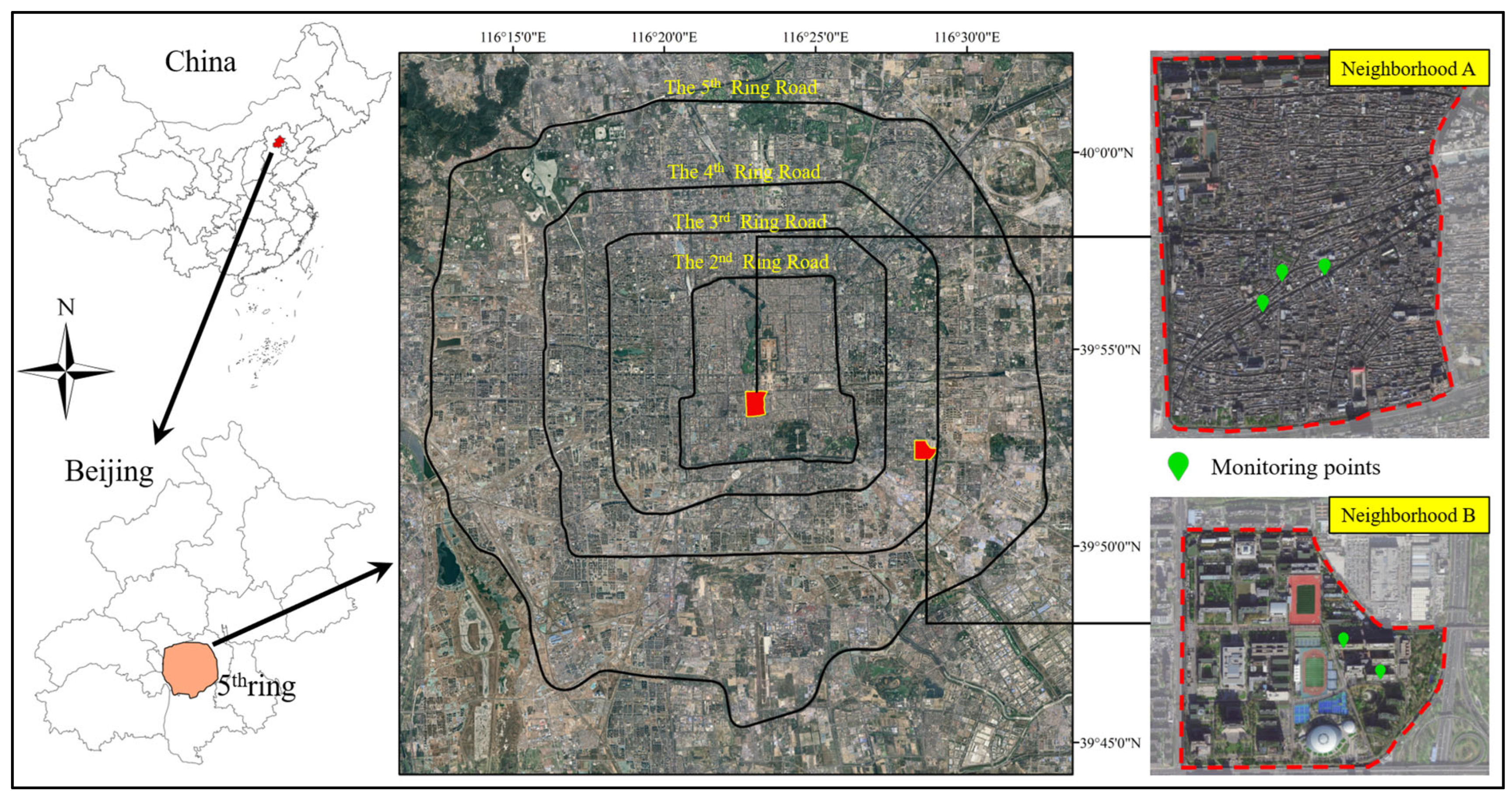


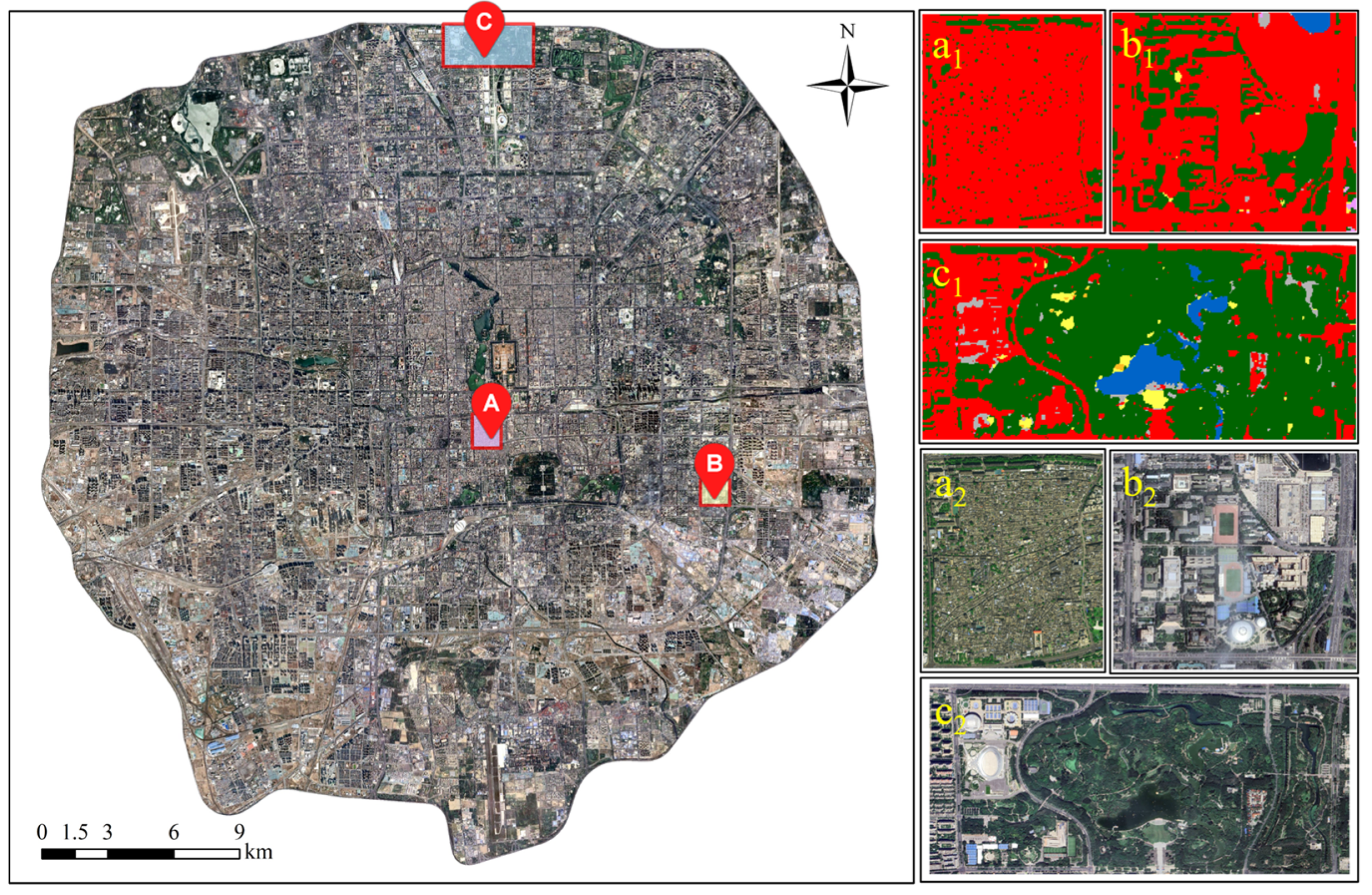
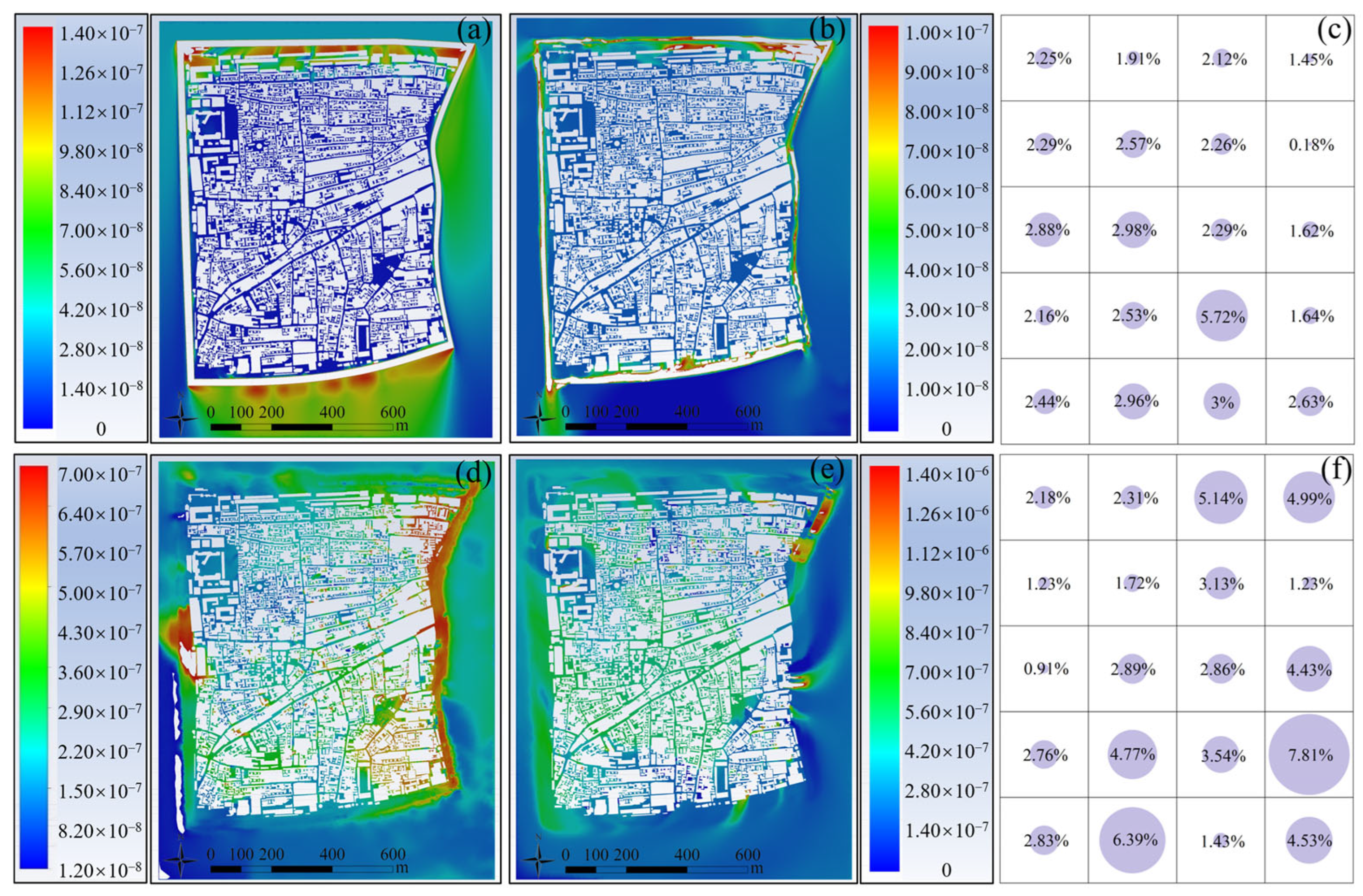
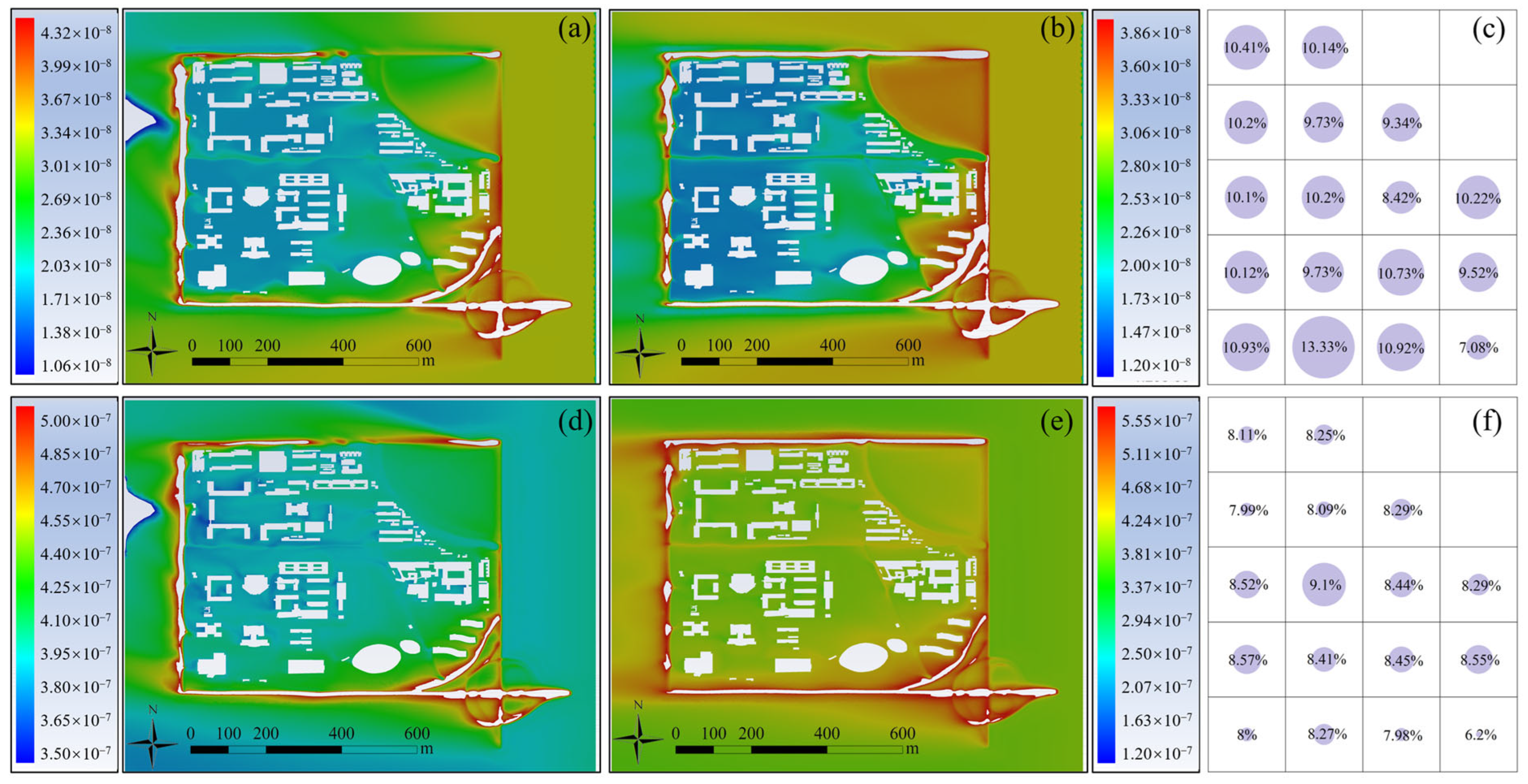
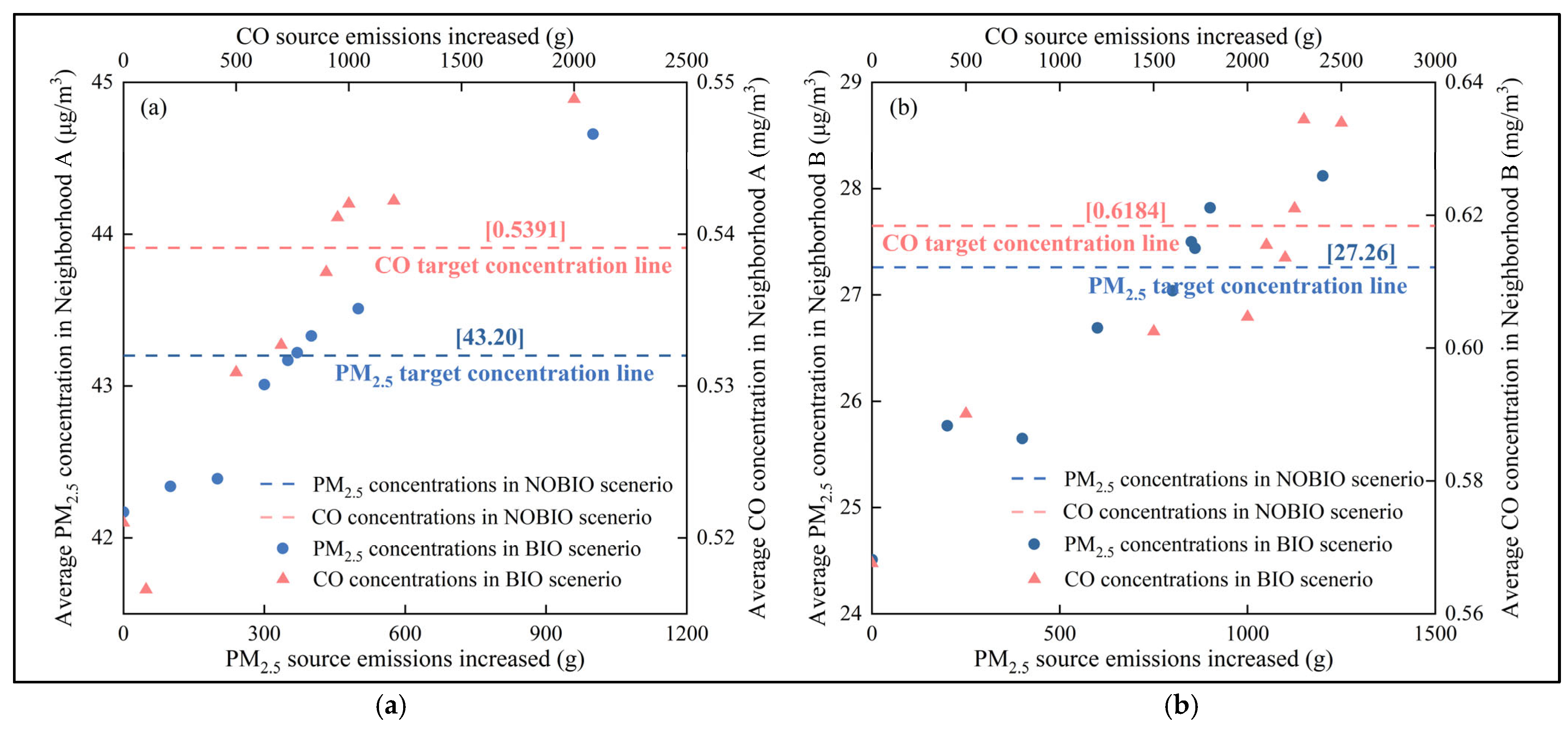
| Neighborhood | Variable | (Math.) Pairwise Difference | ||||||
|---|---|---|---|---|---|---|---|---|
| Mean | Standard Deviation | Mean Standard Error | Difference 95% Confidence Interval | t | Sig. | |||
| Lower Limit | Upper Limit | |||||||
| A (23) | PM2.5 | −1.08494 | 2.73799 | 0.57091 | −2.26894 | 0.09905 | −1.9 | 0.071 |
| CO | −0.00527 | 0.06779 | 0.01414 | −0.03459 | 0.02404 | −0.373 | 0.713 | |
| B (22) | PM2.5 | −0.47536 | 3.26158 | 0.69537 | −1.92146 | 0.97075 | −0.684 | 0.502 |
| CO | 0.00427 | 0.01262 | 0.00269 | −0.00133 | 0.00986 | 1.586 | 0.128 | |
Disclaimer/Publisher’s Note: The statements, opinions and data contained in all publications are solely those of the individual author(s) and contributor(s) and not of MDPI and/or the editor(s). MDPI and/or the editor(s) disclaim responsibility for any injury to people or property resulting from any ideas, methods, instructions or products referred to in the content. |
© 2025 by the authors. Licensee MDPI, Basel, Switzerland. This article is an open access article distributed under the terms and conditions of the Creative Commons Attribution (CC BY) license (https://creativecommons.org/licenses/by/4.0/).
Share and Cite
Cai, B.; Cheng, H.; Xiang, F.; Wang, H.; Kang, T. Modeling the Effects of Vegetation on Air Purification Through Computational Fluid Dynamics in Different Neighborhoods of Beijing. Buildings 2025, 15, 995. https://doi.org/10.3390/buildings15070995
Cai B, Cheng H, Xiang F, Wang H, Kang T. Modeling the Effects of Vegetation on Air Purification Through Computational Fluid Dynamics in Different Neighborhoods of Beijing. Buildings. 2025; 15(7):995. https://doi.org/10.3390/buildings15070995
Chicago/Turabian StyleCai, Bin, Haomiao Cheng, Fanding Xiang, Han Wang, and Tianfang Kang. 2025. "Modeling the Effects of Vegetation on Air Purification Through Computational Fluid Dynamics in Different Neighborhoods of Beijing" Buildings 15, no. 7: 995. https://doi.org/10.3390/buildings15070995
APA StyleCai, B., Cheng, H., Xiang, F., Wang, H., & Kang, T. (2025). Modeling the Effects of Vegetation on Air Purification Through Computational Fluid Dynamics in Different Neighborhoods of Beijing. Buildings, 15(7), 995. https://doi.org/10.3390/buildings15070995





